Commander-in-Chief of the Iranian Armed Forces
Farmandeye Koll-e Qova (Persian: فرمانده کل قوا), formerly known as Bozorg Arteshtaran (Persian: بزرگارتشتاران) is the highest military position in Iran with the authority over all Armed Forces within the country.
According to the Constitution of the Islamic Republic of Iran, the position is vested in the Supreme Leader of Iran and is held since 1981.
Commander-in-Chiefs
After the Persian Constitutional Revolution
| № | Portrait | Name | Term of office | Length of term | Military rank | Service Branch | ||
|---|---|---|---|---|---|---|---|---|
| | ||||||||
| 1 |  |
Shah Mozaffar ad-Din Qajar |
5 August 1906 | 3 January 1907 | 151 days | N/A | N/A | |
| 2 |  |
Shah Mohammad Ali Qajar |
3 January 1907 | 16 July 1909 | 2 years, 194 days | N/A | N/A | |
| – |  |
Regent Alireza Khan |
16 July 1909[1] | 22 September 1910 | 1 year, 56 days | N/A | N/A | |
| – | 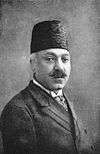 |
Regent Abolqasem Khan |
22 September 1910[1] | 21 July 1914 | 3 years, 314 days | N/A | N/A | |
| 3 | 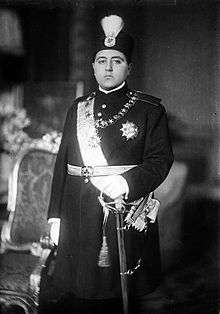 |
Shah Ahmad Qajar |
21 July 1914[1] | 14 February 1925 | 11 years, 147 days | N/A | N/A | |
| 4 |  |
Prime Minister Reza Khan[lower-alpha 1] |
14 February 1925[2] | 15 December 1925 | 304 days | Brigadier general | Persian Cossack Brigade (1894–1921) | |
| | ||||||||
| 1 | 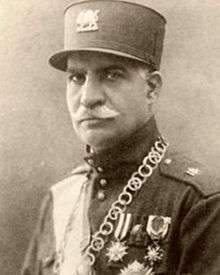 |
Shah Reza Pahlavi |
15 December 1925 | 16 September 1941 | 15 years, 275 days | Brigadier general | Persian Cossack Brigade (1894–1921) | |
| 2 |  |
Shah Mohammad Reza Pahlavi |
16 September 1941 | 21 July 1952 | 10 years, 309 days | Captain[3] | Imperial Iranian Army (1936–1941)[3] | |
| 3 | 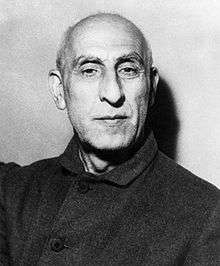 |
Prime Minister Mohammad Mossadegh[lower-alpha 2] |
21 July 1952 | 19 August 1953 | 1 year, 29 days | N/A | N/A | |
| (2) |  |
Shah Mohammad Reza Pahlavi |
19 August 1953 | 11 February 1979 | 25 years, 176 days | Captain | Imperial Iranian Army (1936–1941) | |
| | ||||||||
| 1 |  |
President Abolhassan Banisadr[lower-alpha 3] |
5 February 1980 | 10 June 1981 | 1 year, 125 days | N/A | N/A | |
| 2 |  |
Supreme Leader Ruhollah Khomeini |
10 June 1981 | 3 June 1989 | 7 years, 358 days | N/A | N/A | |
| 3 | 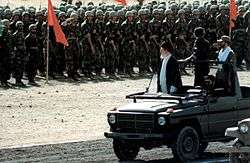 |
Supreme Leader Ali Khamenei |
4 June 1989 | present | 27 years, 186 days | N/A[lower-alpha 4] | Islamic Revolutionary Guards Corps (24 November 1979–24 February 1980)[6] | |
References
- ↑ Appointed by the Parliament of Iran.[2]
- ↑ Mossadegh was granted emergency powers by Shah of Iran to rule by decree.[4] While holding office as the Prime Minister and Minister of War (renamed to "Ministry of National Defence") simoltaniously, Mossadegh went over the authority of Shah the Commander-in-Chief vetted in the Persian Constitution of 1906 and appointed commanders in Imperial Iranian Army and Police.[5]
- ↑ Appointed by the Supreme Leader of Iran.
- ↑ He was caretaker of the Islamic Revolutionary Guards Corps, the highest position in the corps.[6] At the time military ranks were not used.
- 1 2 3 Sheikh-ol-Islami, M. J. (July 28, 2011) [December 15, 1984]. "AḤMAD SHAH QĀJĀR". In Yarshater, Ehsan. Encyclopædia Iranica. 6. I. New York City: Bibliotheca Persica Press. pp. 657–660. Retrieved March 15, 2016.
- 1 2 Elton L. Daniel (2012). The History of Iran. ABC-CLIO. p. 136. ISBN 0313375097.
- 1 2 Ali Akbar Dareini (1998). The Rise and Fall of the Pahlavi Dynasty: Memoirs of Former General Hussein Fardust. Motilal Banarsidass Publ. pp. 15–16. ISBN 8120816420.
- ↑ James Buchan (2013). Days of God: The Revolution in Iran and Its Consequences. Simon and Schuster. p. 64. ISBN 1416597778.
- ↑ John Prados (2006). Safe for Democracy: The Secret Wars of the CIA. Ivan R. Dee. pp. 102–103. ISBN 1615780114.
- 1 2 Detailed biography of Ayatollah Khamenei, Leader of Islamic Revolution, Khamenei.ir, retrieved 17 March 2016
This article is issued from Wikipedia - version of the 11/27/2016. The text is available under the Creative Commons Attribution/Share Alike but additional terms may apply for the media files.